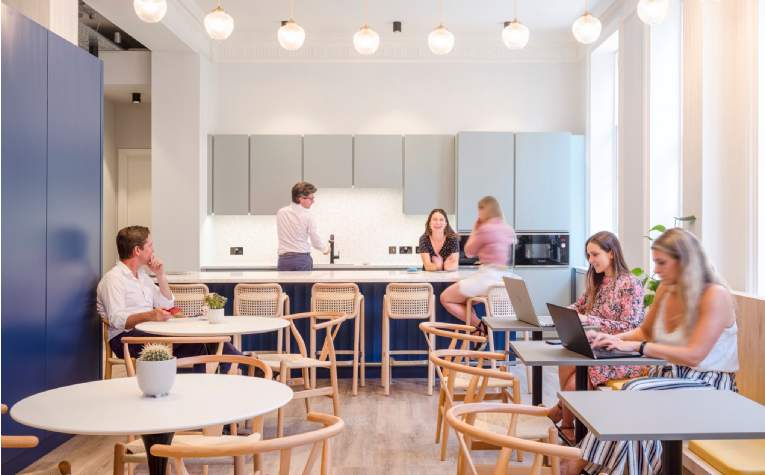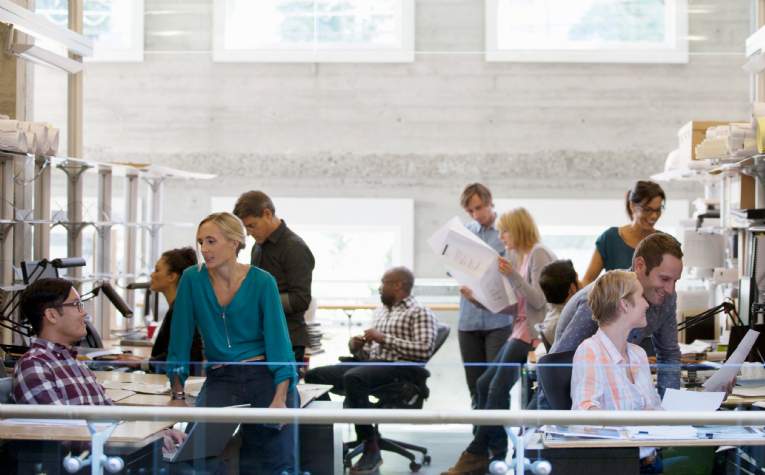Life sciences is a broad branch of scientific study responsible for developing groundbreaking products, services and knowledge that impact our daily lives. It is an industry that becomes more cross-disciplinary by the day, with fields such as bioengineering and bioinformatics leading pivotal discoveries in medicine and medical devices. In line with the complex problems they seek to solve, life sciences companies need creative, forward-thinking workplace solutions now more than ever.
The status quo of sterile, rigidly planned, fluorescent-lit labs can no longer serve the needs of this fast-moving sector. Shifting demographics and expectations, stricter environmental standards and a greater need for blended, interdisciplinary spaces are a few of the factors that will continue to nullify these outdated images of the life sciences lab and reshape the work experience.
Let’s take a look at some of the most prevalent trends and developments influencing life sciences work environments now:
An influx of multidisciplinary talent from other industries is bringing new ways of working
Life sciences is becoming more interdisciplinary, driving a corresponding shift in the skills and qualifications employers seek. Businesses in this sector must now compete with banking and tech for data analysts, data scientists, IT specialists and professionals with hybrid skillsets combining science, computational and business operations knowledge. Professionals coming from a tech company may be accustomed to flexible or agile seating (often unassigned), activity-based working, or a range of amenities not commonly seen in life sciences. These experiences and expectations will influence how life sciences companies accommodate their employees and plan their workplaces in the future.
Digitization and automation are creating demand for new space typologies
Technological advances are yielding powerful new tools to collect, analyze and share data. Automation, AI, and machine learning are enabling researchers to perform advanced analysis of data while cloud technologies allow teams to share information remotely. Few workspaces highlight this more than a laboratory environment. For example, as robotics and automation take on more repetitive tasks with minimal need for human intervention, scientists can monitor experiments off-site.
The cumulative effect of these advancements is less time spent in the lab physically working on experiments. Scientists and researchers may now benefit from more non-lab office space, or alternatively, coworking spaces and incubator hubs outside of the company, to support seamless working and collaboration between team members on- or off-site.
Layout and infrastructure of labs must be highly adaptable and flexible
To accommodate rapidly changing lab equipment, new ways of working and collaboration across multidisciplinary activities, life sciences labs must now be equipped for maximum flexibility. Strategic planning and design choices can allow labs to adapt and change as needed over time. Some of these options include mobile benching, a structural grid that accommodates different layouts and easy access to services, and plug-and-play service infrastructure.
Traditional labs have little or no provision for cross-departmental collaboration, spontaneous encounters, or informal meetings. Lab layouts can be organized to support different workflows, enabling, for example, a natural shift from heads-down work to meetings and group work with appropriate breakout and open spaces. With the right balance, individualized research can flourish alongside planned and unplanned collaboration.
Write-up space must be reassessed for better comfort and functionality
Write-up space, or the areas immediately outside of the lab where scientists perform heads-down work – data processing, analysis, writing abstracts and other tasks – has long been treated as an afterthought in the overall design of laboratories. This is a missed opportunity, which, if approached differently, could have a significant impact on productivity. Understanding that younger generations of scientists are bringing higher expectations for the quality of workspace, and with a wealth of examples in other sectors, such as tech to look to for inspiration, write-up space is due for a refresh.
In lieu of standard cubicles, where density can deter concentration, write-up space can be planned and designed to afford greater privacy, better access to natural daylight and enough room for quick, informal conversations with colleagues. Prioritizing the effectiveness and appeal of these spaces will give scientists and researchers better settings in which to focus and perform the essential functions that support their experiments inside the lab.
Generational shifts are bringing new expectations for workplace policies and culture
A younger and more diverse workforce, drawn from both science and a broader range of industries, is bringing a different set of expectations for their work experience. These professionals want more horizontal, transparent structures; team-centric workspaces and flexible work arrangements for better work-life balance. While flexibility in work hours and locations ranks high for these employees, Gen Z and younger Millennials still value being in a physical workplace for mentorship and career guidance. Life sciences companies, like those in many other industries, must consider the unique needs of their professionals and tailor work policies and spaces to meet these new expectations.
Employees expect their companies to embody ESG goals
As an industry with a significant environmental footprint, life sciences is looking to decarbonize beyond regulatory compliance, in line with industry-specific guidelines and net zero agendas. Increasingly, ESG-related offerings and policies are becoming a core tenet of companies’ value propositions, including energy and waste management, enhanced customer welfare, ethical marketing, and workforce health and wellbeing. Employees expect their workplaces to have a positive impact, and studies have shown that staff retention in this sector is often aligned with an organization’s ESG performance.
Life sciences firms are increasingly setting KPIs based on stakeholder engagement questionnaires and interviews, alongside sources such as the SASB Materiality Map. The workplace provides a wealth of opportunities for achieving such KPIs while improving occupant experiences. From designing lab or office spaces for low-carbon, resilient operations, introducing green or circular initiatives or engaging suppliers who have a focus on health and sustainability, organizations can now make a positive impact and live the ESG principles they adopt.
Staying Focused on Innovation
The life sciences sector is known for pioneering discoveries that improve our lives. To continue driving this level of innovation, the workplaces where these advancements happen must adapt to changing conditions. By prioritizing flexibility and collaboration in workplace planning, companies can support the interdisciplinary nature of life sciences work and create environments conducive to driving scientific breakthroughs. Embracing new work styles, essential technologies and sustainability will ultimately enable businesses to stay competitive, both in the marketplace of ideas and for high-skilled talent.
.jpg)
.jpg)
.jpg)

.jpg)
.png)
.png)
(1).jpg)
